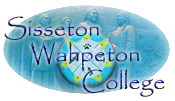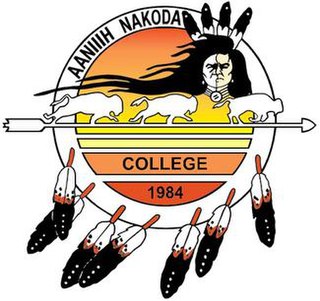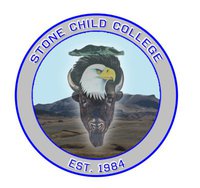Related Research Articles
The American Indian Higher Education Consortium (AIHEC) was established in 1972 to represent the interests of the newly developed tribal colleges, which are controlled and operated by American Indian nations. The four founders were Gerald One Feather of the Oglala Sioux Community College, David Reisling of D-Q University, Pat Locke of the Western Interstate Commission for Higher Education (WICHE), and Helen Schierbeck of the United States Office of Education (USOE). They organized the initial meeting and brought together all who wanted to form such a national organization.. One of the most significant achievements of AIHEC was to work with the United States Congress to authorize in 1994 land-grant status to 29 tribal colleges, achieved in October 1994 under the Elementary and Secondary Education Reauthorization Act.
Northwest Indian College is a public tribal land-grant community college in Bellingham, Washington. It was established by the Lummi Nation and is the only accredited tribal college or university serving reservation communities of Washington, Oregon, and Idaho.

Iḷisaġvik College is a public tribal land-grant community college in Utqiaġvik, Alaska. Operated by the North Slope Borough, a home rule government of the Iñupiat, it is the only tribally controlled college in Alaska, and it is the northernmost accredited community college in the United States. The college is located within the boundaries of the North Slope. It is an 89,000-square-mile (230,000 km2) region of Arctic tundra. It is connected to the 414-mile (666 km) Dalton Highway only during the winter, by an ice road for local residents. The community can also be reached by plane.

Fort Peck Community College (FPCC) is a public tribal land-grant community college in Poplar, Montana. The college is located on the Fort Peck Assiniboine & Sioux Reservation in the northeast corner of Montana, which encompasses over two million acres. The college also has a satellite campus in Wolf Point.
United Tribes Technical College (UTCC) is a private tribal land-grant community college in Bismarck, North Dakota. In 2012, UTTC had an enrollment 885 students, 635 full-time undergraduates, and 250 part-time undergraduates.

Salish Kootenai College (SKC) is a private tribal land-grant community college in Pablo, Montana. It serves the Bitterroot Salish, Kootenai, and Pend d'Oreilles tribes. SKC's main campus is on the Flathead Reservation. There are three satellite locations in eastern Washington state, in Colville, Spokane, and Wellpinit. Approximately 1,207 students attend SKC. Although enrollment is not limited to Native American students, SKC's primary function is to serve the needs of Native American people.

Bay Mills Community College (BMCC) is a public tribal land-grant community college in Brimley, Michigan. It is chartered by the federally recognized Bay Mills Indian Community of Michigan with a total enrollment of approximately 500 on-campus and online students. The students come primarily from Michigan's eastern Upper Peninsula and are 60% Native American. BMCC is a member of the American Indian Higher Education Consortium (AIHEC), a community of tribally and federally chartered institutions working to strengthen tribal nations, and a land-grant college.

Sisseton Wahpeton College (SWC) is a Public tribal land-grant community college of the Sisseton Wahpeton Oyate on the Lake Traverse Reservation in South Dakota. It was established in 1979 and serves the Dakota people. SWC has an average enrollment of about 250 students, of whom more than 80% are tribal members. It has both vocational and academic programs, and arrangements with four-year colleges so that students can transfer for continued studies.

Little Priest Tribal College is a public tribal land-grant community college in Winnebago, Nebraska. It is a member of the American Indian Higher Education Consortium and primarily supported by the Winnebago Tribe of Nebraska. It has an enrollment of 135 students, of which 90 percent are American Indian.
Leech Lake Tribal College (LLTC) is a public tribal land-grant community college in Cass Lake, Minnesota. It was established in 1990 and designated a land-grant college in 1994. The college includes approximately 70 faculty, staff, administrators, and 250 students. Most students come from the Leech Lake and Red Lake Reservations, and approximately 8% of the student population is non-Indian.

Southwestern Indian Polytechnic Institute (SIPI) is a public tribal land-grant community college in unincorporated Bernalillo County, New Mexico, with an Albuquerque postal address. It is federally operated by the Bureau of Indian Affairs and funded through the Bureau of Indian Education, both agencies within the United States Department of the Interior. More than 120 different Indian Tribes are represented in SIPI's student body.

Chief Dull Knife College is a public tribal land-grant community college on the Northern Cheyenne Indian Reservation in Lame Deer, Montana. It is an open-admission college with about 141 students. On average, more than half of its graduates move on to four-year colleges.

In the United States, tribal colleges and universities (TCUs) are a category of higher education, minority-serving institutions defined in the Higher Education Act of 1965. Each qualifies for funding under the Tribally Controlled Colleges and Universities Assistance Act of 1978 or the Navajo Community College Act ; or is cited in section 532 of the Equity in Educational Land-Grant Status Act of 1994.
Comanche Nation College was a two-year, open admissions, American Indian tribal college. It was located in Lawton, Oklahoma, the capital of the Comanche Nation. The school was chartered in 2002 by the Comanche Nation Business Committee. Comanche Nation College operated until July 31, 2017.
Lac Courte Oreilles Ojibwe College (LCOOC) is a public tribal land-grant community college in Hayward, Wisconsin. It is one of two tribal colleges in the state of Wisconsin. The enrollment averages 550 students. The LCOOC has a main campus in Hayward. More than one-third of students are enrolled at the four outreach sites at Odanah, Bayfield, Hertel, and Lac du Flambeau.

Aaniiih Nakoda College is a public tribal land-grant community college on the Fort Belknap Indian Reservation in Harlem, Montana. The institution incorporates native culture into the curriculum and promotes cultural identity; however, the school is open to both tribal and non-tribal members. Aaniiih Nakoda College is a member of the American Indian Higher Education Consortium (AIHEC), which is a community of tribally and federally chartered institutions working to strengthen tribal nations and make a lasting difference in the lives of American Indians and Alaska Natives. ANC was created in response to the higher education needs of American Indians. ANC generally serves geographically isolated populations that have no other means accessing education beyond the high school level.

Stone Child College (SCC) is a public tribal land-grant community college in Box Elder, Montana. SCC is affiliated with the Chippewa-Cree Tribe and located on the Rocky Boy Indian Reservation in north central Montana; it is one of seven Tribal Colleges in Montana. In 2008–09, SCC had an enrollment of 511, of whom 98 percent were American Indian descent; 20 percent were bilingual or of limited English proficiency. SCC students range in age from 17 to 72, with the average age at 30. The college retention rate is 47 percent and the graduation rate is 20 percent.

Tohono Oʼodham Community College (TOCC) is a public tribal land-grant community college in Sells, Arizona. TOCC's student body is 88 percent American Indian/Alaskan Native. Tohono Oʼodham Community College serves approximately 216 students. The college's faculty and staff is 57 percent American Indian, half of whom are Oʼodham.
Red Lake Nation College is a public tribal land-grant community college on the Red Lake Indian Reservation in Red Lake, Minnesota. It is fully accredited by the Higher Learning Commission and enrolls about 150 students. The college is supported by elders and community members who speak the Anishinaabe language and who understand the history of the Red Lake Nation.
Saginaw Chippewa Tribal College (SCTC) is a public tribal land-grant community college in Mount Pleasant, Michigan. The college was established in 1998 by the Saginaw Chippewa Tribal Committee.
References
- ↑ "AIHEC–Tribal College Journal (TCJ)". aihec.org. Retrieved 2008-10-27.
- ↑ "Tribal College Journal Editor Awarded Fellowship to Stanford University". 2007-06-22. Retrieved 2008-10-27.